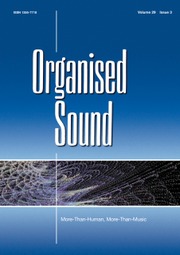Article contents
The exploitation of ‘tangible ghosts’: conjectures on soundscape recording and its reappropriation in sound art
Published online by Cambridge University Press: 18 January 2001
Abstract
As if the (terrified) Photographer must exert himself to the utmost to keepthe Photograph from becoming Death. But I, already an object, I do notfight. (Barthes 1988: 14)
Perhaps this is the ultimate way of playing with reality. (Baudrillard 1997: 38)
Every day the urge grows stronger to get hold of an object at very close range by way of its likeness, its reproduction. (Benjamin 1992: 217)
This paper is born out of my experience as an electroacoustic composer/soundartist and consumer, who passionately engages in the procurance, employmentand exchange of soundscape recordings: an ambivalent engagementwhich is aesthetically rewarding, yet on further reflection deeplyunsettling. The aim of this paper is to question and explore why thisostensibly benign and increasingly common procedure (i.e. the routine ofsoundscape recording/sampling/abstracting, editing, retouching,transforming, mixing, recontextualising . . . ) may result in a durableconfrontation with ‘terror’ accompanied by ethicalcompromise. To articulate a personal and intuitive response, I will refer tocritical writings on photography to illuminate sound (i.e. utilising thephotograph as a counterpoint to the sonic record). I will be focusing inparticular on the recording and the reappropriation of humanutterance in electro-acoustic music, as it is probably the most intimate, aswell as familiar, sonic material to humans. You cannot escape from your own voice.‘Soundscape’ denotes ‘any acoustic field of study’ (Schafer 1994: 7); however, in this context I wish to focus on acoustic fields which have a particular social or cultural significance.‘To photograph is to appropriate the thing photographed.’ (Sontag 1984: 4) Thus it is appropriated again when employed in sound art.
Information
- Type
- Student Article
- Information
- Copyright
- © 1999 Cambridge University Press
- 7
- Cited by

